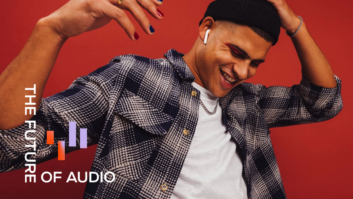A Broadcast Technology Consultant Envisions a New and Profitable World for Broadcasters Thanks to DAB
“Someday we’ll be broadcasters of bits.”
Glynn Walden, then of USA Digital Radio, said this to me in 1995. But over the past decade we have seen a lot of “datacasting” ideas come and go with little success, and they have given us a healthy suspicion of every datacasting fad that comes along.
Gosh, even the word “datacasting” has a 1980s feel to it! How can we get out of the rut that keeps real bitcasting only a pipe dream in radio broadcasting – and what’s missing in the digital broadcasting arena that keeps profitable bitcasting tantalizingly out of our reach?
In a word, it’s infrastructure. We lack the infrastructure needed to make our broadcasting of bits compelling and profitable from the start.
A company called Impulse Radio has the way to do this. I am a partner in a firm that advises the company.
Its mission is simple: to provide the industry with a business reason to be digital. Impulse Radio will provide the content and the tools to make radio bitcasting as addictive and compelling and profitable as your station’s audio programming is.
New thinking
Impulse Radio will change our thinking about how to use data on a radio station.
Start with the most apparent bitcasting tool available to us today, RBDS. Too many RBDS boxes are plugged into FM transmitters that are doing nothing but transmitting station IDs. Those of us who have more information available in digital form at the studio may have gone one step further – by posting song titles and artist names as the music plays.
Yet, there is no industry-wide way to make money with our RDBS streams. The lion’s share of the income on RBDS is not related to the station’s programming, but from side deals that use RBDS capacity as a private subscription service offering things from GPS corrections to nearly-real-time stock data. This is not broadcasting.
So if there is no money in program-related data on RBDS, surely there should have been audience relationship building potential in it. However, it is hard to imagine that displaying song titles and station IDs is enough to drive people to upgrade to the latest RBDS radio.
Based on our experience with RBDS, it sure looks like data is a dead end, but it’s just the victim of a self-fulfilling prophecy. Consumers don’t seem to want it. Broadcasters wait for more radios to be sold before being sold on it. Consumer electronics manufacturers wait for broadcasters to put in some excitement that drives consumers to the stores. Each stakeholder in RBDS waits for someone else to make the concept useful, and nothing happens.
Impulse Radio knows that we can use our expertise as broadcasters to make digital content work. After all, broadcasters know how to create an audio “stream” that is compelling and addictive. We know how to sell our P-1s to one kind of advertiser and our cumes to another. We know how to do it so revenue exceeds expenses and our stations can thrive.
Stick with strengths
Impulse Radio says to make bitcasting successful we have to look at the bitcasting stream the way we look at the audio stream on our stations. We need lots of content produced elsewhere that we assemble locally and transmit to ubiquitous receivers. To make our audio program today, we get music from record companies, programs from syndicators, news from news services, weather, facts, information, you name it, from outside sources.
We assign avails within the format of the audio schedule and fill them with spots either made in-house, or sent to us from the advertisers’ agencies. Then we glue it all together with local voices and production to give our stations a local personality.
The data stream should be modeled after our audio stream. Why stray from our strengths? All we need is the infrastructure to make data content a compelling and addictive adjunct to the audio program. Fill the datastream with entertaining content and paid spots the way we know how to do with audio. Then use the data content to engage the listener the way we use the audio to grab the listener.
Stations can’t do this on their own, especially when stations are running leaner and meaner than ever before. No one has time to create a data broadcast from scratch, with content that doesn’t exist, for play on receivers that don’t exist. We need the infrastructure to be ready to captivate, ready to sell.
Here are the pieces of the digital puzzle that have to be assembled:
• First, we need a dynamic digital platform that can handle the transmission of data in a flexible and standardized way.
IBOC is in a testing phase with the NRSC now, and it looks like digital radio may indeed prove to be more desirable to the consumer than analog radio. This is the platform for “broadcasting bits” to consumers that we have been waiting a long time for.
• Next, we need a standardized way to transmit a variety of data objects over the radio that the consumer can – and wants to – receive.
We need to figure out how to make the data work in a low-capacity display, such as in a car where you can’t have too much going on. At the same time, we need to be able to wow our audiences with more sophisticated presentations on other kinds of radios. None of this can happen unless the broadcasters and the manufacturers work out the details together, based on consumer feedback.
• Finally, we need a way to start from the very first day you turn on your first IBOC transmitter.
This is where the infrastructure comes in. IBiquity has been working closely with manufacturers to work out the hardware details both on transmission and reception.
Enter Impulse Radio, iBiquity’s latest alliance partner.
This company started with a simple premise: if you are going to transmit a profitable datastream you need compelling and addictive content. It needs to be running from day one. It needs to be easy for the station to plug in and administer. It needs to be able to support itself while there are few digital radios in the marketplace, yet be able to grow into a local revenue generator when there are enough digital radios in your listeners’ hands.
Impulse Radio is building the infrastructure necessary to get real public bitcasting off the ground. They are building the relationships our industry needs with advertisers, content providers, record companies and the like. They are building the connections to make the content manageable and fresh.
The result will be a steady flow of new and compelling data content that you can easily customize to your station’s liking. Content formats will be based on open standards so you can produce your own material as needed.
Impulse Radio and iBiquity have joined forces to chart the course toward profitable bitcasting to the masses. IBiquity’s relationships with receiver manufacturers will guide the development of new radios with hot new features. Impulse Radio’s relationships with content providers will create the library necessary to deliver good content nationwide from the start.
With iBiquity’s hardware and Impulse Radio’s content resources and management tools, we’ll have the infrastructure in place to make mass bitcasting a profitable reality. By becoming “broadcasters of bits,” our radio stations will shed the stodgy image of old technologies and keep us ahead of competing media. With a bitcasting infrastructure in place, we’ll take full advantage of the benefits of going digital, and we’ll create new features that will sell radios and bring us closer to our audience.












